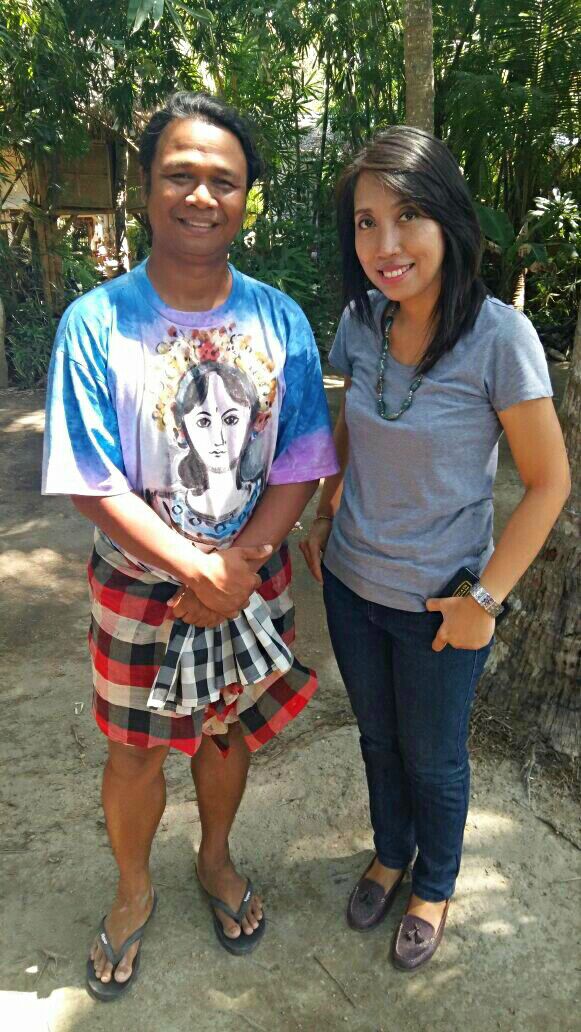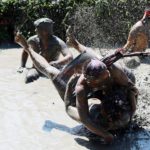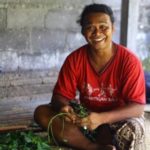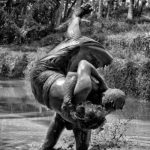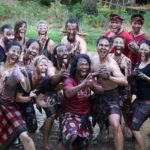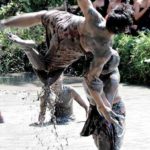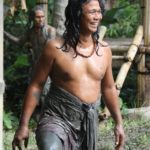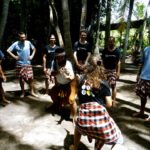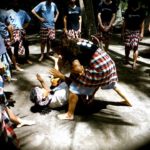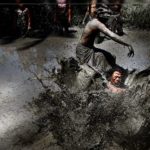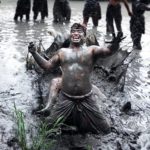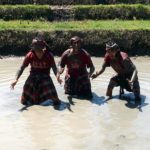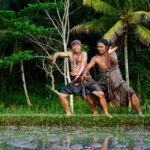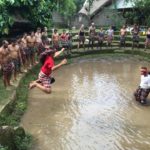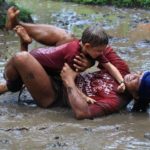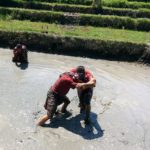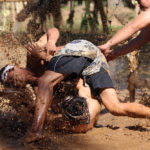Written and Translated by: Aye Dewi Sri. Canggu, Bali, Indonesia. May 8, 2015.
Edited by: Jessyca Y. and Chris L.
Editors Note – Every attempt has been made to preserve the original Bahasa Indonesian dialogue. Where clarity was needed, the phrases have been edited for a Western audience.
A Unique Form of Fighting: “Mepantigan” Martial Arts Take Root in Bali
Indonesia may not be the first place you think of when talking about martial arts, but as long as you know that the martial arts in Indonesia is quite unique. MEPANTIGAN, refers to the variety of fighting systems native to or developed in the Indonesian archipelago. Both the age-old traditional arts, Indonesian martial arts include spiritual aspects to cultivate inner strength, spiritual harmony, release stress, and learn valuable lessons of camaraderie beyond simply physical training.
There are hundreds of variants within the diverse styles of martial arts movements. By 1948, all of the types of martial arts that existed in Indonesia became called by a name: Pencak Silat. Later, the study and practice of martial arts dwindled in demand. Many in Indonesia consider martial arts to be archaic, old fashioned, backward, and no longer relevant to modern life.
Meet Putu Witsen Widjaya. Now age 46, he was born on the island of Bali, Indonesia. He is the founder and inventor of Mepantigan, a unique form of martial arts that took root on the island of Bali. Black belt Putu Witsen Widjaya is a Tae Kwon Do champion and with more than 20 years experience as a martial arts fighter.
He developed the Mepantigan – a blend of Indonesian fighting movement, wrestling, throwing and grappling – in 2003. I recently sat down with Putu Witsen Widjaya at his home at Batubulan Village, Sukawati, Gianyar. I have been very lucky to meet and interview him about the unique forms of Mepantigan and also had a front row seat to see his show.
Interview With Putu Witsen Widjaya
Slickster: Okay, let’s take it from the beginning. What does Mepantigan mean?
Putu Witsen Widjaya: The word of Mepantigan comes from the Balinese words meaning to “push” or “throw.” Mepantigan was done by two people who tried to push and throw each other until one of competitors drops to the ground.
Some martial arts are designed to hone the mind and body. Some are used as exercise or some are designed to exact violence, so what is Mepantigan designed for?
Yes I agree with you, Dewi. Indonesian martial arts are an ancient art with no clear beginning, though some masters believe it was created by watching the movements of self defense and dropping of their enemies. This makes sense because the fighting style is all about exploiting weaknesses in your foe and incapacitating them as quickly as possible.
But now times have changed. We need to introduce our martial arts to the outside the world in a more positive way. This was a good reason for me to design Mepantigan as a flagship of martial arts from Bali island. It is not only about fighting and wrestling, Mepantigan is also filled with shades of indigenous culture.
It can make its practitioners gain physical fitness, release stress, and learn valuable lessons of friendship as well. I have developed Mepantigan as traditional sport that emphasizes emotion and spiritual intelligence. This martial art can develop inner character and avoid violence, while cultivating compassion.
Tell me, when and where did you learn the martial arts, and how long have you been teaching?
I learned Taekwondo from a Korean master in Jakarta since I was in junior school. After I graduated high school, I decided to move back to Bali. Since then, I met with some martial arts teachers in Bali and learned martial arts. Then one day I was inspired to promote Balinese culture and tradition into a martial art.
This martial art combines with other fighting styles or other martial arts as well as with the Balinese culture. How did that happen?
Yes, this is the uniqueness of Mepantigan. Mepantigan is a form of Balinese martial arts that involves similar physical techniques that combine some self-defenses, such as Tae Kwon Do, Silat, Capoeira, kickboxing, and judo. This martial art also includes various elements of Balinese culture, such as Balinese music, dance, and costumes.
That is the difference between Mepantigan and other martial arts in Indonesia and other countries. Fusing fighting with the performing arts to create an entirely new cultural phenomenon. When Mepantigan begins the contestants will wear uniforms consisting of traditional Balinese clothing, and compete in any open space in the mud of rice fields.
You say that this martial art must be performed in the mud? Wow… It’s great! Is this another uniqueness of Mepantigan?
Yes. I even have patented it… (laughter)
First, I was inspired to hold Mepantigan on the beach at Sanur during 2003 along with my family and friends. It looked quite exotic when the competitors, greased with coconut oil and were fighting on the sand. After three years I have developed this martial art. I began to think how to develop it elsewhere, where it could be more fun but keep it integrated with the surrounding nature. Then in 2006 I found the idea; Mepantigan in the mud or muddy field.
Why mud? I just wanted to blend this martial art to the earth and mud, as a medium for rice cultivating, is very important to Balinese peoples. Besides, there is an added challenge itself… When the participants are slammed into the mud, the mud will make the movements more hard and slower. So, I think this will be very interesting.
Yeah, I think it is very interesting. So could you please tell me how to do Mepantigan? Is it hard to play?
(Laughter) You do not have to worry, Dewi! No need to be proficient in martial arts to be able to do Mepantigan. The emphasis of Mepantigan is on throwing and pushing. But there is no fear and no hurt. The arena where it takes place is in a wet and muddy field. These make the martial art more safe and fun as well.
Great! Sport and fun is a good combination. So, are there any rules and levels in Mepantigan?
No, there are no strict rules in Mepantigan. I wanted to create a martial art that encompassed culture and Balinese values, not only kicks and takedowns, but dancing, theater and music as well.
There are three levels of Mepantigan, beginner is for kids. Intermediate levels are for students and advance levels are for adult practitioners. One game is played in two rounds and one round is held for three minutes. Punching, kicking, biting, or striking of vital parts of the opponent’s body is forbidden. Before the fight, they must first perform the preliminary demonstration of the martial art (Balinese dancing). After the pre-demo, there will be an instruction from the referee and they will begin to try to tackle down each other.
Both of the fighters should wear Balinese traditional uniform such as sarong. To show respect and supportive manner, fighters should hug and bow to each other before and after the show. The winner and the loser are decided based on the score of the fighters, which is determined by juries. Martial art demonstrations of technique earns one point, successfully locking the opponent earns two points, effectively throwing the opponent earns three points, and aggressiveness and politeness earns four points.
Some of the martial arts were never “martial” in the sense of being used by professional warriors, so in Mepantigan… What do you think about it?
Hard question… Need more spirit, I guess! (laughter)
At the beginning, it is very difficult, but I believe there will always be a way. I agree, martial arts was created for self-defense and knocking down the opponent, but a touch of the performing arts will create an entirely new cultural phenomenon.
When I was practicing Tae Kwon Do, a master from Korea came over to give a workshop. He was very serious and cared too much about his status as master. All he did was give us orders and expected us to obey. I didn’t like this…too stiff, awkward and too many rules in it. That moment taught me many things. I do not just want to introduce an Indonesian ancient martial art, but also share the flexibility of our culture and traditions.
So how can you attract participants to get involved?
I began to introduce Mepantigan in 2002. I introduced it to my family, folk and friends. Then, I started to introduce this martial art to the international school in Bali. Many expatriates were interested and I was getting excited. Mepantigan increasingly became known as the Balinese Martial art to the outside world.
Then, in 2003 I held the first event of Mepantigan on Sanur beach. Many foreign participants joined and took part. In 2006 I was working to expand Mepantigan to Ubud, the most famous tourist destination in Bali, and successfully held the first event in this area.
But, my first debut was in 2008. The First Open Mepantigan Bali Championship was held at the Green School Bali, the one and only based school culture and preserve the environment with most the student come from abroad. Many took part in the Mepantigan – men and women, from small children to adults, with weight categories ranging from light and middle up to heavy. It was so excited.
Since then, Mepantigan finally become popular and widely held in several locations in Bali and outside Bali such as Jakarta, Bandung and Yogjakarta. I also had been invited to perform the Mepantigan Bali to many art performances in some destination in Europe.
Hmm… I wonder why should westerners want to do Mepantigan ?
Many of Mepantigan participants from abroad (especially Westerners) they study and learning Mepantigan because they find something special and unique in Mepantigan. Not only as art for self-defense, but also containing cultural elements and methods for learning about life from art, philosophy, and even the value of spiritualism.
Finally, you has popularized the Mepantigan to the outside world. So how do you feel? Are you quite satisfied?
Yes, I am very proud but not satisfied …(laughter)
Mepantigan nowadays not only has become a Balinese martial arts but also as performing arts which is combined with dance and music. Many are involved in this journey. I was very concerned about Bali island as one of the famous tourist destination in the world.
With the growing tourism industry in Bali, I would like to popularize the Balinese martial arts more wide by continuing teaching tourists the Mepantigan. I hopes Mepantigan can be bridge to gain an appreciation from other country and attract them to come and visit Bali.
Your goal is very noble, Mr. Putu. I really appreciate it. Speaking of people around you, who inspired you and what makes them so special?
Hmmmm… Many peoples around me give me inspiration and support, but the thing that most inspired me was Kebo Iwa, a legendary giant warrior in Bali. Kebo Iwa was lived in 14th century who, by himself, had trained some war soldiers the art of Balinese fighting techniques and willingness to die for the Indonesia archipelago.
Yes, I am also proud of him…. Salut… So what are your next plans?
Well, there is much work I have to finish. I will continue to practice and develop Mepantigan, which is always in line with our local wisdom.
Currently, I am not only teaching Mepantigan at schools and inviting tourists to show and practice the Mepantigan, but I am also involving inmates in prison. I think it’s a very important progress, to teach them a unique form of fighting by promoting the spirit of togetherness, solidarity, and sportsmanship.
With a lot of tasks and many plans to do next, its many took part in the Mepantigan. So right now I am preparing my family to regenerate and continue my mission. Maybe one day I will get an idea to present Mepantigan in a new format. It requires a lot of resources and effort, right. You can also help me, Dewi.(laughter)
Really? I am flattered. So what special message would you like to share with Mepantigan to the peoples around the world?
Indonesian martial art is a tradition handed down to us as a part of our Indonesian heritage that must be maintained, developed, and preserved. For me, Mepantigan is not just about a way of fighting or of art combined with culture and tradition, but is something importance that has to be understood and maintained.
I came up with Mepantigan as Indonesia martial arts with fighting components and incorporated all aspects of Balinese culture and I would say to the world that this martial art is part of the identity of the Indonesian nation which is humble, characteristic, and full of tenderness. I wish Mepantigan will become an international martial art one day.
Wise words from a master of Mepantigan!!! And I wish what you wish for will come true. Thanks, Mr. Putu, for taking the time to speak with me. I do hope Mepantigan is going to be a success in the next future.
Thanks so much, Dewi. Please don’t forget to come back next time…
How To Play Mepantigan
General
- Before the actual full body contact wrestlers are supposed to perform ngigel (Balinese dance)
- Both fighters must wear traditional Balinese clothes called sarong or kamen.
- Fighters are allowed perform throwing, sweeping creasing and locking.
- Punching, kicking, biting, or hitting vital parts of the opponent’s body is forbidden.
- Before and after fighting, should bow or hug each other to show the respect and sportive.
- The fight is to be performed at the beach or mud of the rice fields for two round for three minutes long each round.
Scoring
- Martial art demonstration earns one point.
- Successfully locking the opponent earns two points.
- Effectively throwing the opponent earns three points.
- Aggressiveness and politeness earns four points.
